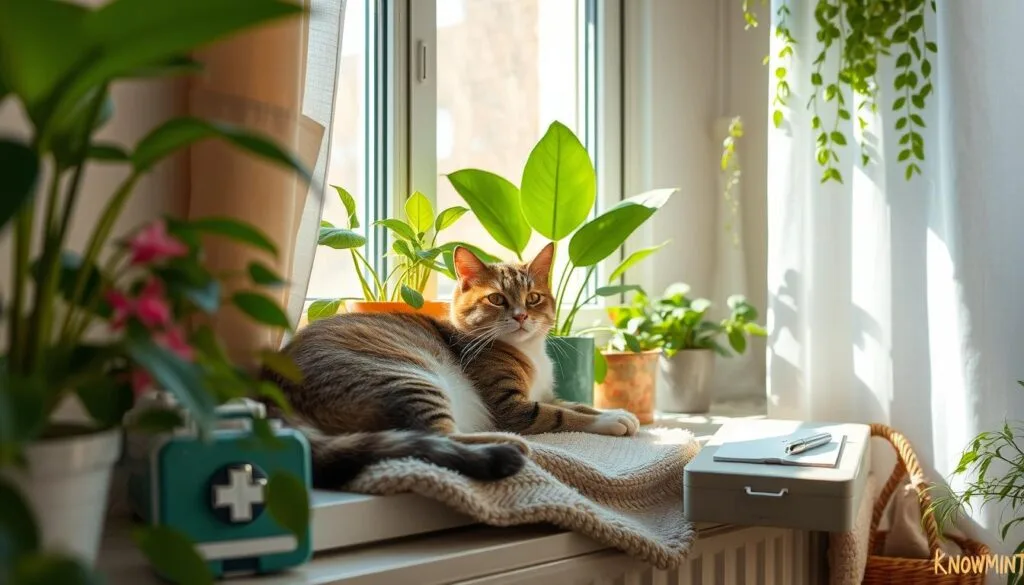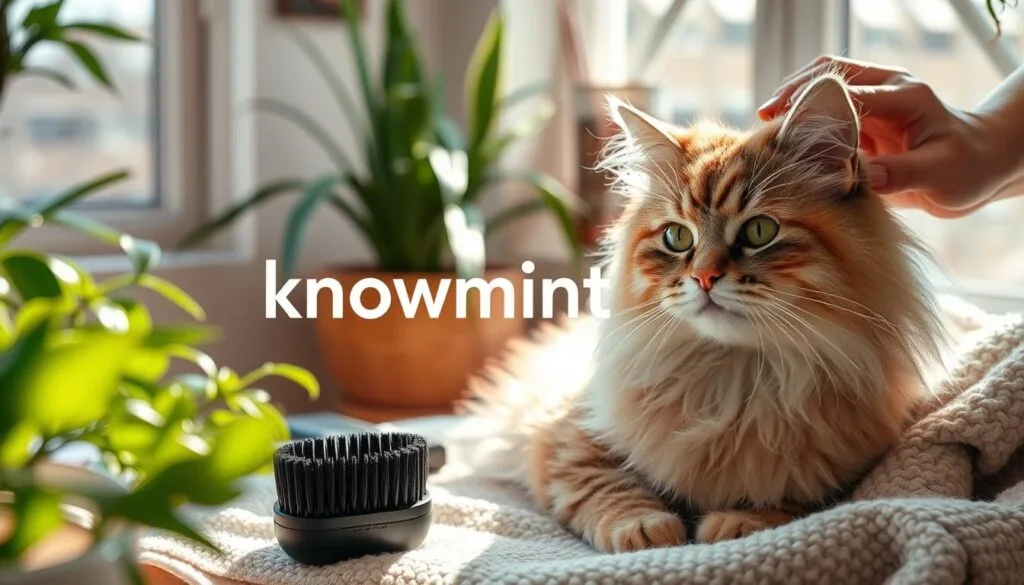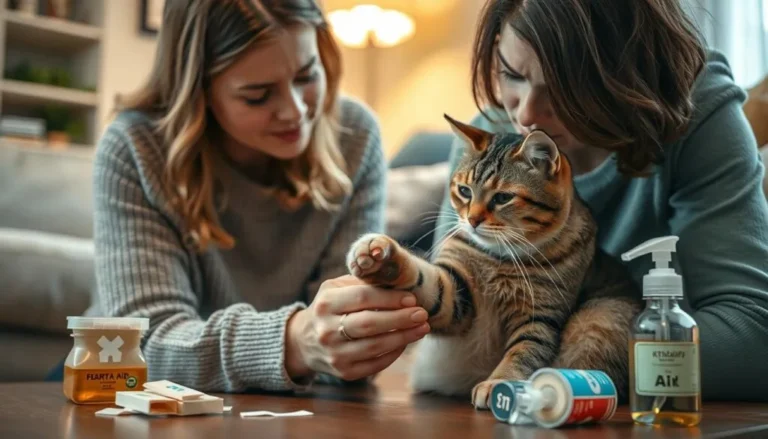How to Take Care of a Cat: 7 Vet-Recommended Tips

Bringing a cat into your home can be very rewarding. But, it also means you must care for them well. Your main goal is to make sure your cat is happy and healthy. With the right help and effort, caring for a cat can be very rewarding.
In this guide, we’ll share seven key tips from vets. These tips will help you understand how to care for your cat. You’ll learn about their needs, health, and how to keep them happy.
Key Takeaways
- Understand your cat’s physical, emotional, and environmental requirements to ensure their well-being.
- Invest in essential supplies and create a safe, comfortable living space for your feline friend.
- Provide proper nutrition and hydration, and learn how to monitor your cat’s health and wellness.
- Prioritize regular veterinary care and preventive measures to keep your cat healthy and happy.
- Engage your cat in enriching activities and interactive play to stimulate their mind and body.
Understanding Your Cat’s Basic Needs
Caring for a cat is more than just food and shelter. It’s about meeting their physical, emotional, and environmental needs. This ensures your cat is happy and healthy.
Physical Requirements
Cats need a balanced diet, regular grooming, and vet care to stay healthy. Giving them the right food, keeping them clean, and taking them to the vet helps a lot. This keeps them cat health and long-lived.
Emotional Requirements
Cats have emotional needs that are often ignored. They need cat behavior enrichment like toys and playtime. This keeps them happy and prevents boredom or stress. Paying attention to their feelings strengthens your bond.
Environmental Requirements
The place where your cat lives is key to their happiness. Make sure your home is safe, comfy, and fun. This includes spots to rest, places to hide, and sunlight. These things help take care of a cat and meet their needs.
By meeting your cat’s physical, emotional, and environmental needs, you create a great home for them. This approach to cat behavior and care makes them thrive. Your cat will live a happy, fulfilling life with you.
Essential Supplies for Your New Feline Friend
Bringing a new cat home is thrilling, but it needs planning. You’ll need to get the right supplies to keep your cat happy and healthy. This guide will show you how to set up a great space for your cat breeds with everything from food bowls to cat toys.
Feeding Essentials
- High-quality cat food (dry and/or wet)
- Food and water bowls
- Measuring cups for proper portion control
Cat Litter Training Necessities
- Litter box (one more than the number of cats)
- Litter scooper
- Cat litter
Grooming and Hygiene
- Brush and comb
- Nail clippers
- Cat shampoo (if necessary)
Enrichment and Playtime
| Item | Purpose |
|---|---|
| Scratching posts | Satisfy a cat’s natural need to scratch and stretch |
| Cat toys | Provide mental stimulation and physical activity |
| Cat trees and perches | Allow your cat to climb, perch, and survey their territory |
Getting these essential supplies will make your home comfy and fun for your new cat. Remember, every cat is different. Be ready to change and add things as your cat grows and changes.
Proper Nutrition and Feeding Guidelines
It’s key to make sure your cat eats right for their health. Knowing about feline nutrition helps you take care of a cat better.
Choosing the Right Cat Food
Finding the right cat food is the first step. Choose foods high in protein, suited for your cat’s age and health needs. Stay away from fillers and pick foods rich in amino acids, vitamins, and minerals.
Feeding Schedule and Portions
- Kittens and young cats need to eat more often, about 3-4 times a day, to grow fast.
- Adult cats usually eat twice a day, keeping a regular schedule.
- Adjust the food amount based on your cat’s age, activity, and body shape, as the food package suggests.
Water and Hydration Tips
Drinking enough water is vital for your cat’s health. Make sure they always have clean, fresh water. Adding wet food to their diet can also help with staying hydrated.
Learning about feline nutrition and feeding them right is crucial. It helps your cat stay healthy and happy. Talking to your vet can give you more tips on what’s best for your cat.

How to Take Care of a Cat’s Health and Wellness
Keeping your cat healthy is key to their happiness and long life. As a cat owner, you must focus on their health. This means regular vet visits, preventive care, and knowing when they’re sick.
Preventive Healthcare
Regular vet visits are the base of your cat’s health care. Your vet can give important services like vaccinations, parasite prevention, and dental care. It’s best to see the vet once a year to check on your cat’s health and catch problems early.
Recognizing Signs of Illness
It’s important to know when your cat is not feeling well. Look for changes in their appetite, energy, grooming, or litter box use. These signs can mean they have a health issue. If you see anything odd, call your veterinarians near me for help.
Importance of Dental Care
Dental health is crucial for cats but often ignored. Regular brushing, dental cleanings, and watching for dental disease can prevent pain and keep their mouth clean. Talk to your vet about the best dental care for your cat.
By focusing on your cat’s health, watching for illness signs, and caring for their teeth, you can help them live a long, happy life. Remember, regular vet visits and proactive care are key to taking care of a cat well.
| Preventive Healthcare Checklist | Frequency |
|---|---|
| Veterinary Checkups | Annually |
| Vaccinations | Annually or as recommended by your veterinarian |
| Parasite Prevention | Monthly or as recommended by your veterinarian |
| Dental Cleanings | Annually or as recommended by your veterinarian |

“Regular veterinary check-ups and preventive care are essential for ensuring your cat’s long-term health and well-being.”
Creating a Safe and Comfortable Living Space
It’s key to make a safe and comfy home for your cat. This includes cat-proofing and picking the right bed. These steps help meet your cat’s behavior and needs.
Setting Up Your Home
When taking care of a cat, your home must be safe and easy to get around. Look for hazards like cords, sharp edges, and toxic plants. Make sure your cat has a place for food, water, litter, and sleep to keep things tidy.
Cat-Proofing Essentials
- Secure loose cords and wires to prevent entanglement or chewing
- Store cleaning products, medications, and other potentially harmful items in a secure cabinet
- Provide ample vertical space for climbing and perching, such as cat trees or wall-mounted shelves
- Ensure all windows and doors have screens or barriers to prevent your cat from escaping
Choosing the Right Cat Bed
Choosing the right bed is important for your cat’s comfort. Think about size, material, and where it goes. A soft, cozy bed in a quiet spot can make your cat feel safe and happy.

By making a safe and comfy home, you help your cat’s behavior and care. This ensures they are happy and healthy.
Grooming and Hygiene Maintenance
Keeping your cat clean and well-groomed is key for their health. Regular cat grooming keeps their coat and skin healthy. It also strengthens your bond with your pet. Let’s look at the grooming practices that will keep your cat looking and feeling great.
Brushing and Bathing
Brushing your cat’s coat weekly removes loose hair and prevents matting. It also spreads natural oils through their fur. This routine helps reduce hairballs by preventing hair ingestion.
For long-haired cats, brushing more often is needed to avoid tangles. An occasional bath is sometimes necessary to remove dirt or grease. Use a gentle, cat-safe shampoo and rinse well. Make the bath a positive experience with treats and praise.
Nail Trimming
- Trim your cat’s nails regularly to prevent overgrowth and discomfort.
- Use cat-specific nail clippers and only cut the clear tip, avoiding the quick.
- If your cat is nervous, start by gently handling their paws and gradually introduce trimming.
Dental Care
Dental health is important but often overlooked. Brush their teeth with a soft-bristled toothbrush and cat-safe toothpaste to prevent plaque and gum disease. Dental treats and chews help keep teeth clean between brushings.
| Grooming Task | Frequency |
|---|---|
| Brushing | Weekly |
| Bathing | As needed |
| Nail Trimming | Every 2-4 weeks |
| Teeth Brushing | 2-3 times per week |
By sticking to a grooming routine and making it enjoyable, you can keep your cat healthy. This helps take care of a cat in the long term.

Exercise and Mental Stimulation
It’s important to make sure your cat gets enough exercise and mental play. Cats are naturally curious and love to move. Giving them chances to play and think can make them happier and prevent bad behavior.
Indoor Activities
There are many ways to keep your cat active indoors. Try setting up cat towers, scratching posts, and fun toys. These encourage climbing, jumping, and playing with their paws. Switching toys often keeps your cat interested and stops boredom.
Interactive Play Sessions
Playing with your cat regularly is a great way to bond and keep them active. Use toys like wands, laser pointers, or crumpled paper balls. These activities let your cat chase and jump, just like they would in the wild.
Enrichment Tools
- Puzzle feeders and treat-dispensing toys challenge your cat’s problem-solving skills and stimulate their natural foraging behavior.
- Hiding treats or toys around the house can provide mental stimulation as your cat searches for them.
- Introducing new scents, such as catnip or essential oils, can pique your cat’s curiosity and encourage exploration.
Adding different activities to your cat’s daily life keeps them healthy and happy. A well-stimulated cat is a happy and well-adjusted one.

Regular Veterinary Care and Prevention
Keeping your cat healthy means regular vet visits. These include annual check-ups, shots, and treatments to prevent diseases. It’s important to find a good vets near me for your cat’s care.
Regular vet visits help catch health problems early. Shots protect your cat from diseases like rabies and feline leukemia. Also, treatments for fleas and ticks keep your cat safe from parasites.
- Schedule annual wellness visits with your veterinarian
- Ensure your cat’s vaccinations are up-to-date
- Discuss preventive care options, such as flea, tick, and heartworm prevention
Before your vet visit, write down questions and talk about any changes in your cat. This helps your vet give the best care for your cat.
| Routine Veterinary Visits | Recommended Frequency |
|---|---|
| Wellness Exams | Annually |
| Vaccinations | Annually or as recommended by your veterinarian |
| Flea, Tick, and Heartworm Prevention | Monthly or as recommended by your veterinarian |
Regular veterinary care and prevention are key for your cat’s health. A good vet is essential for your cat’s well-being.
Conclusion
Caring for a cat means you must meet their basic needs. This includes giving them the right food and healthcare. It also means making sure they have a safe and fun place to live.
Understanding cat health and feline nutrition is key. This way, your cat can be happy and healthy. They will be by your side, bringing joy into your life.
Remember, taking care of a cat is a big responsibility. Cats need routine, attention, and love. Be ready to give them the time and care they need.
With the right approach, you can build a strong bond with your cat. You’ll enjoy the many joys of having a cat as a pet.
By following the tips in this article, you’ll become a great cat parent. Embrace the challenges and rewards of caring for a cat. You’ll get a loyal, loving, and fun companion for many years.
FAQ
1. What are the essential supplies I need for a new cat?
You’ll need food and water bowls, a litter box, and high-quality cat litter. A comfy cat bed, scratching posts, and toys are also key. Don’t forget grooming tools like a brush and nail clippers.
2. How often should I take my cat to the veterinarian?
Take your cat to the vet at least once a year for a check-up and shots. Also, go when you notice any health or behavior changes.
3. What are the best ways to keep my cat physically and mentally stimulated?
Use interactive toys and vertical scratching posts. Play with your cat regularly and introduce new items like puzzle feeders. Letting your cat explore and act naturally is crucial.
4. How do I properly groom and maintain my cat’s hygiene?
Brush your cat, trim their nails, and bathe them when needed. Clean their litter box and provide fresh water. This keeps them healthy and prevents problems.
5. What are the most important considerations when choosing a cat food?
Choose a high-quality, balanced diet that fits your cat’s needs. Look for food made by vet nutritionists with high-quality protein as the main ingredient.
6. How can I create a safe and comfortable living environment for my cat?
Cat-proof your home by securing cords and removing hazards. Provide areas for scratching, sleeping, and play. Make sure your cat has perches, beds, and toys to explore.
7. How do I properly introduce a new cat to my home?
Introduce the new cat slowly. Keep them in a separate room with their own supplies. Gradually let them meet other pets and family members. This helps everyone adjust smoothly.






“Your writing style is engaging and clear, love it!”